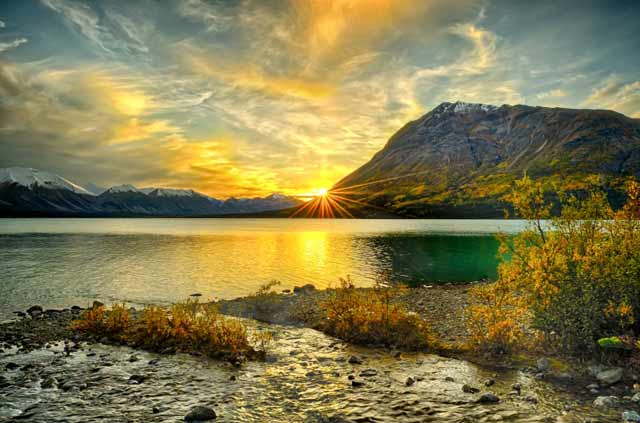
Hope Creek Sunset
While the landscape is quite diverse throughout Alaska, there are plenty of towering mountains, soothing glacial lakes and rivers, and spectacular sunsets to behold no matter what the particular region you visit.
Alaska! Land of the midnight sun! The great land! The last frontier! It is indeed all of those things. In a world more and more dominated by concrete jungles and urban “wildlife” (the human kind) it’s both necessary and refreshing to have truly untamed, massive expanses of wilderness and waters still in existence, as found in places like Alaska.
I can still fondly recall my first visit to the 49th state many years ago. As I drove down the Seward Highway I found myself wanting to take pictures of virtually everything I saw. Stunning snow caped mountain peaks reached heavenward as dall sheep roamed the rugged hill tops. Majestic bald eagles reverently soared about in the cool, thick, ethereal air. Pristine, emerald green trees of various species blanketed the landscape. Brilliant, violet fireweed decorated the roadside vegetation. The deep grayish-blue waters of glacial creeks, lakes and rivers flowed freely through the valleys and meadows, like arteries carrying blood and supplying life to all. Everywhere I looked I saw breathtaking, indescribable beauty and grandeur which would have made a magnificent postcard. I wanted to wrap my arms around all that I beheld. I wanted to somehow vaporize and let my soul forever rest and meld into this earthly paradise. Needless to say, I was hooked! Once the Alaska bug bites, it’s all over! Many years later, through fate and providence, I now call Alaska my home.
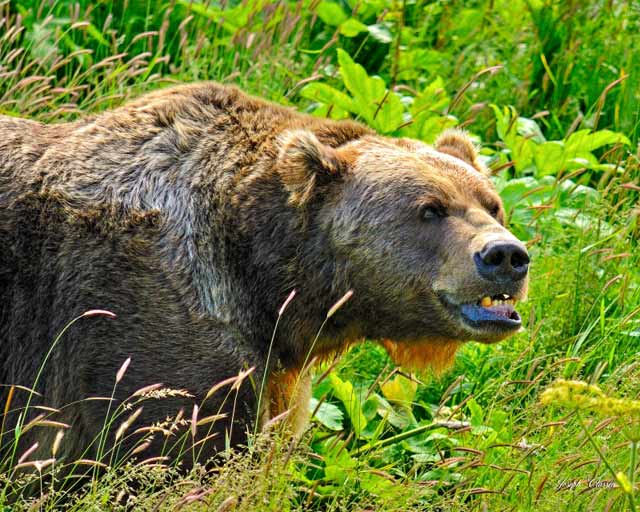
King Kodiak in the Bushes
There is no creature on earth that commands as much respect as a half-ton Kodiak brown bear. Being within close proximity of one is an unforgettable feeling. However, photographing these incredible beasts properly takes a great deal of preparation and knowledge. Your life may truly depend upon it.
The first several times I came up north, it was to pursue fishing and hunting adventures and ultimately fill the freezer with a healthy supply of organic food. But, the more I explored and casually photographed the state, the more serious I got about photography. Eventually, photography turned into the adventure itself. Over the last few years my passion for nature and wildlife photography has exploded! This passion has grown even more, being that I currently live in one of the most photogenic places in Alaska: Kodiak Island. The biggest brown bears on earth, hundreds of majestic bald eagles, life-giving salmon streams and lush mountains are literally right out my window. Every spare moment I have I grab my camera and seek out something to photograph. On some occasions, subjects just seem to magically appear at the right time and place, and on other occasions, I carefully plan every moment of a particular outing to capture a subject during a special time. I often have to wait weeks to perfectly align the tide with the sunrise or sunset, with the right winds, the right weather, etc.
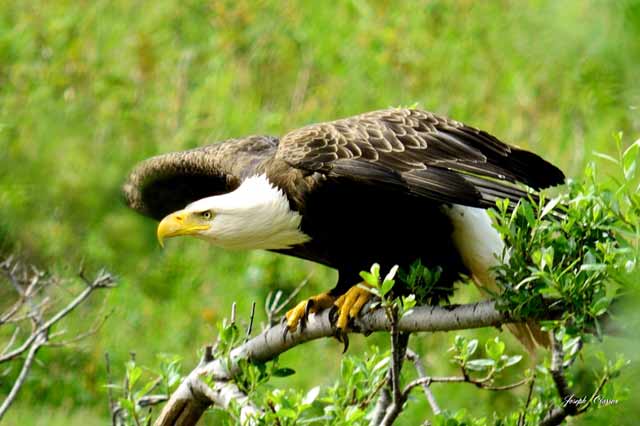
Pasagshak Eagle
Along with finding and photographing eagles at food sources, the other best option is to find where they are roosting and resting. These will usually be places of thick cover and natural wind breaks that are fairly close to their current hunting grounds. Once again, be respectful and keep your distance.
It’s virtually impossible to cover all the details of the subject of photography in Alaska in one short article, but as they say, “a picture is worth a thousand words.” I’ve included a variety of Alaska wildlife photographs throughout this article as an example of some of the critters one may experience in this awesome place! These images you’ll see are representative of a huge portion of the overall state, as I’ve explored Alaska from one side to the other.
Spending time and photographing in Alaska affords a rare opportunity, but capturing great images of the “Great Land” may not be so easy.
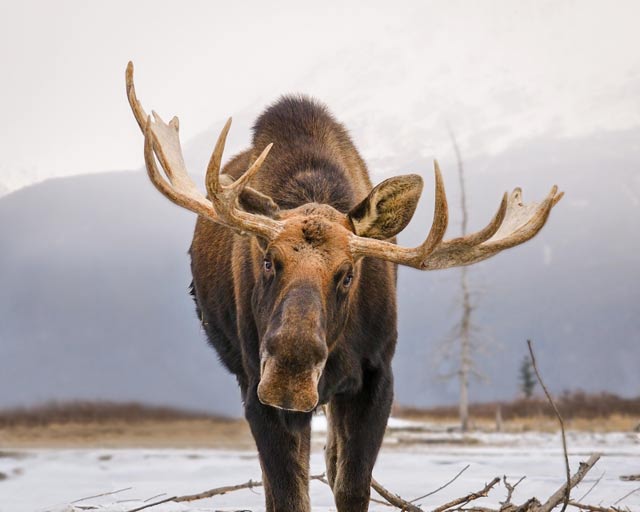
Moose
The mighty Yukon moose is a fairly common sight in many parts of Alaska. This amazing creature can be viewed and photographed in many settings. While they often appear docile, slow, and clumsy, if agitated, one will find out quite quickly that in reality they are quite the opposite. Evenings and mornings are the best time to look for active moose, but during the breeding season, bulls can sometimes be seen on the prowl during the midday hours.
Where does one begin? Let me start by saying that Alaska is no place to fool around! This land very regularly and tragically claims the lives of many an ill-prepared, uneducated outdoor enthusiast and naïve nature lover. It is not Disneyland! It is a place where Mother Nature displays her unbounded beauty in all its glory, but also where she manifests her brutal, savage indifference to life and death. Survival of the fittest reigns supreme…and that includes human beings.
VIEW SLIDESHOW IMAGES
Captions for slideshow images starting with left bullet:
Musk Ox: Seeing a big, hairy, musk ox stomping across the frozen tundra is a rare treat! However, doing so will most likely take lots and lots of searching and patience, not to mention being able to camp out in subzero temperatures for days on end. If you are up to the challenge, head north – way north – to the Brooks Mountain Range and beyond. Also, be sure to bring lots of warm clothes and extra batteries for your camera gear, as the extreme cold will shut down both your body and your photo equipment very quickly.
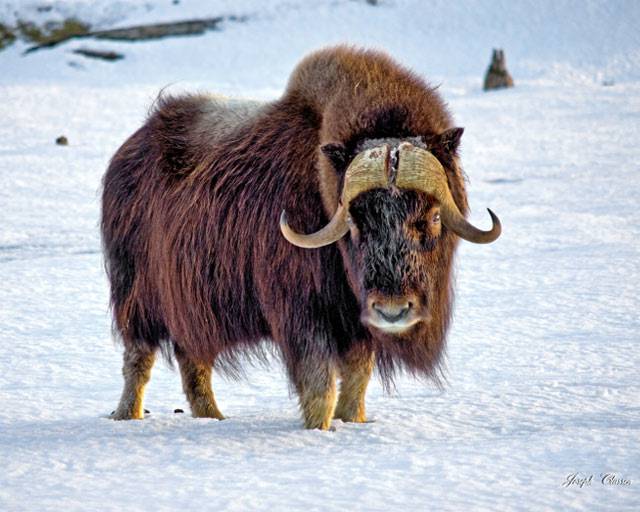
Sunshine Brown Bear: After weeks of snow, rain, and nasty weather, all of creation enjoys a beautiful, sun-shinny day! This brown bear couldn’t help but to smile as she soaked up some rays on a wonderful spring afternoon. But yet again, don’t let your guard down for even a second while being around and photographing potentially very dangerous animals. They deserve and command the greatest respect at all times…for your sake and theirs.
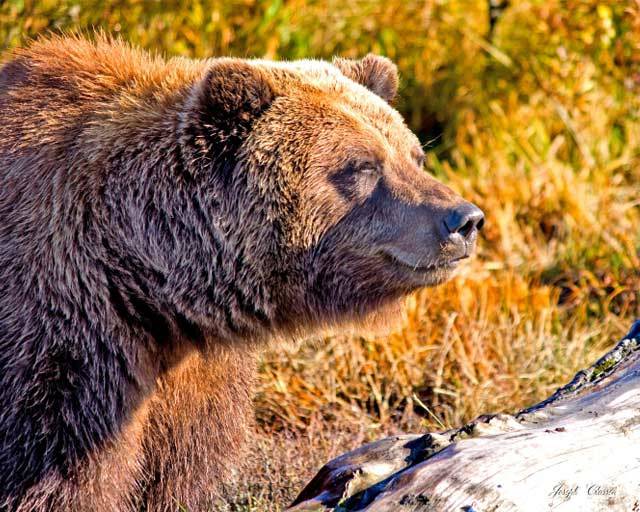
Chiniak Creek Seal: Seals love to eat fish! Find the fish, and you will have plenty of seals to photograph. A great place to look for them is at the mouths of rivers where spawning salmon are entering in great numbers. Seals have very sharp eyesight and they spook very easily. Thus, one must remain very still and hidden to successfully photograph them.
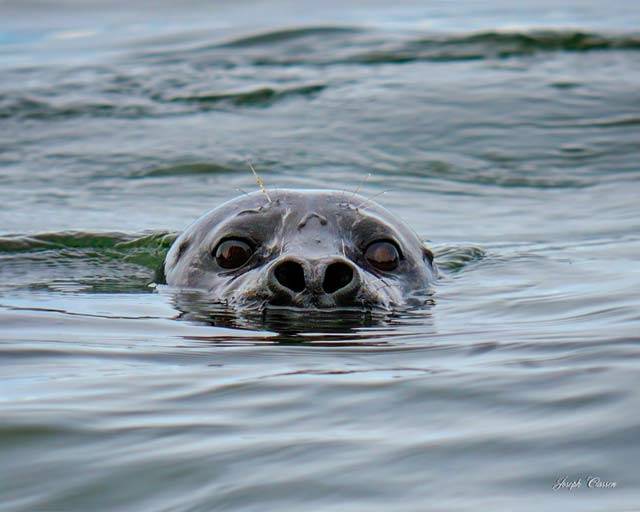
Kodiak Buffalo Profile: While buffalo are not native to many parts of Alaska where they currently reside, there are now healthy herds of them roaming the land in places like Kodiak Island. With a little scouting around, one can find and photograph these wonderful animals from the safety of their vehicle. But even while in a car or truck, keep your distance. An angry bull or protective mother will readily charge if provoked.
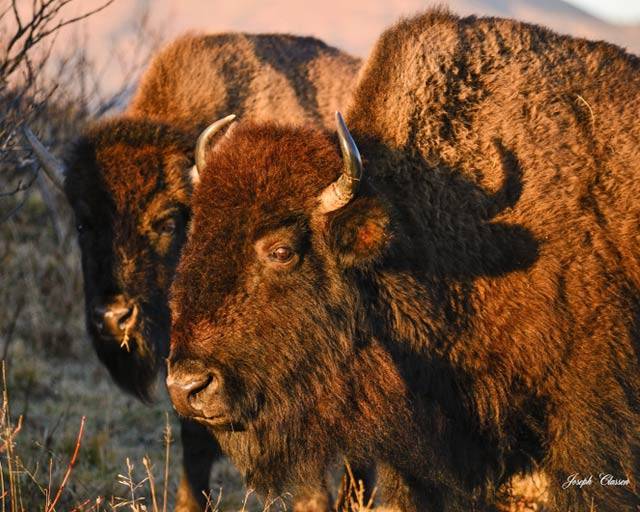
Brooks Range Dall Sheep: Photographing sheep and goats in Alaska can be particularly challenging because of one main factor: they spend most of their time in places that are exceptionally difficult for human beings to reach. However, there are times when they come down to much lower, safer elevations to feed on more abundant food sources during those warmer, more forgiving months of the year. Focus on spring and summer months for the best photographic opportunities.
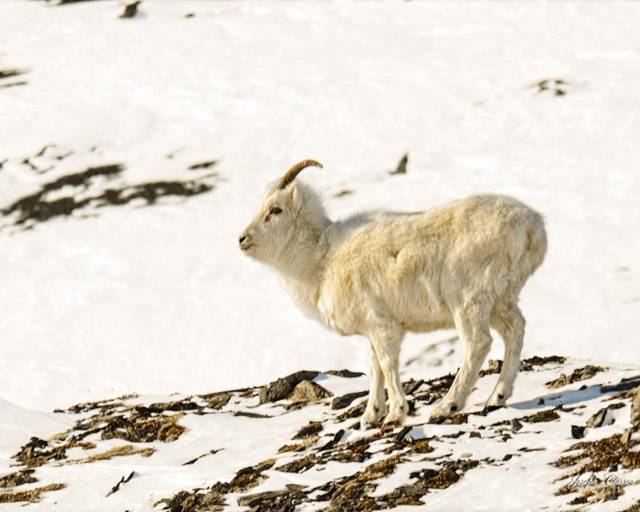
Buskin River Red Fox: Foxes are abundant in many parts of Alaska. Their curious, playful nature makes them fun, and relatively easy subjects to photograph.
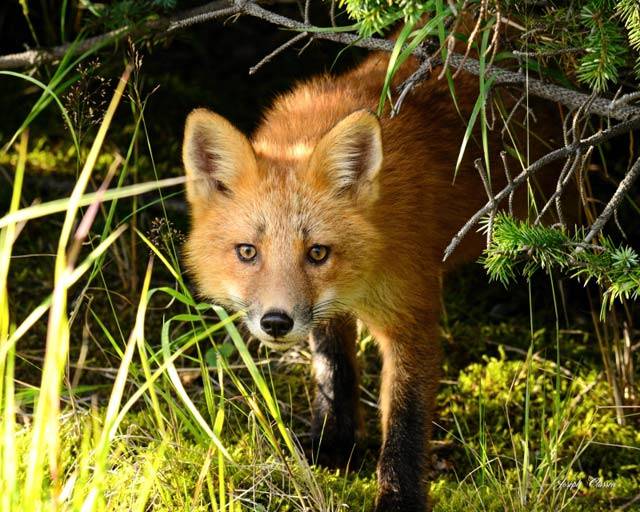
Eagle in Flight: The majestic bald eagle is another creature that is in healthy supply in Alaska. Again, find the fish, and you will find the eagles. While mature eagles (with the white heads) are very cautious around people, the immature birds are not as worrisome. Either way, as with all wildlife, one must keep a respectable distance, use long lenses, and have lots of patience.
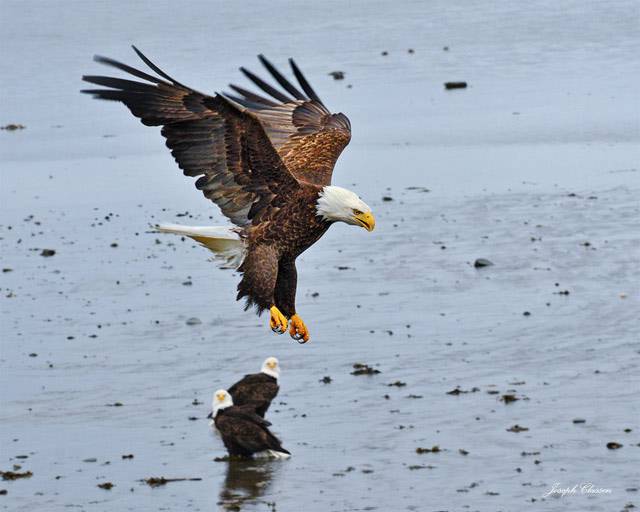
Kodiak Sow and Cub Bonding: While there is nothing as cute in nature as a mother bear with her baby, there is also nothing as dangerous. EXTREME caution is necessary. Most bear maulings in Alaska are the result of someone getting too close to baby bear. Again, have a look at my bear safety article for more information.
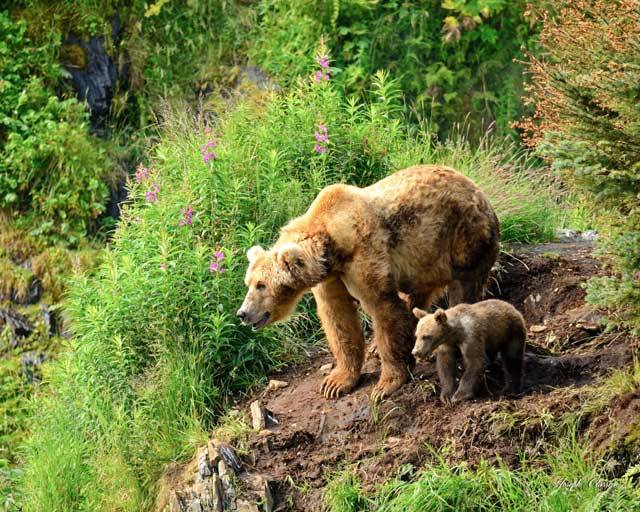
Before you venture up to the frozen tundra, I’d highly recommend doing some serious planning, preparation and homework for your time up here. As with anything in life, “prior preparation prevents poor performance.”
First: Decide what you’d like to primarily photograph and what time of year…migrating wildlife, colorful autumn landscapes, vast seascapes, summer wildflowers, the northern lights, or maybe the frozen tundra of winter.
Second: Do some research to find out what areas are most suited to the subjects you would like to photograph.
Third: Know the functions and use of your camera, lenses and equipment. You won’t want to be spending your time learning about your gear – you’ll want to be creating great images. So, if you’re not a seasoned photographer, practice, practice, practice at home before you arrive. You could practice wildlife photography at a zoo or a park and make images of birds on a pond or lake or in flight.
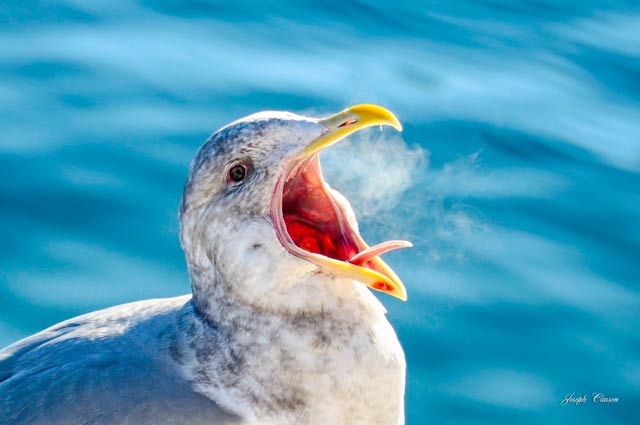
Seagull Breath
Sometimes the most common of birds and animals can offer great photo opportunities. While I was photographing eagles on a cold winter day, this seagull plopped down right in front of me, stretched open his moth to let out a “squawk” and released a wonderful steaming breath that made a great imge – in fact – an award winning photo! Always be prepared for those magic moments that come without warning.
Forth: If wildlife is your priority, then by all means, learn as much as you can about each animal or bird – their behaviors, habits, movements, and habitats. Observe and make slow, quiet movements when you are around them – do not startle them! An animal will give you “warning signals” if you get too close – know what they are and pay attention to those signals! It’s important that both you and the animals remain safe!
Fifth: Start with places that are the safest and most accessible, such as state parks, or, go with a reputable sight-seeing/wildlife viewing guide service. If you are a more adventurous soul and want a “do-it-yourself” Alaskan photo odyssey, you really have some homework to do and preparations to make, but, the memories will last a lifetime. I guarantee it!
NOTE: If you are planning to visit this great state on a self-guided tour, all the planning, knowledge and preparation is even more important! And during your travels and whenever possible, make sure someone knows where you are or where you’re planning to go at all times.
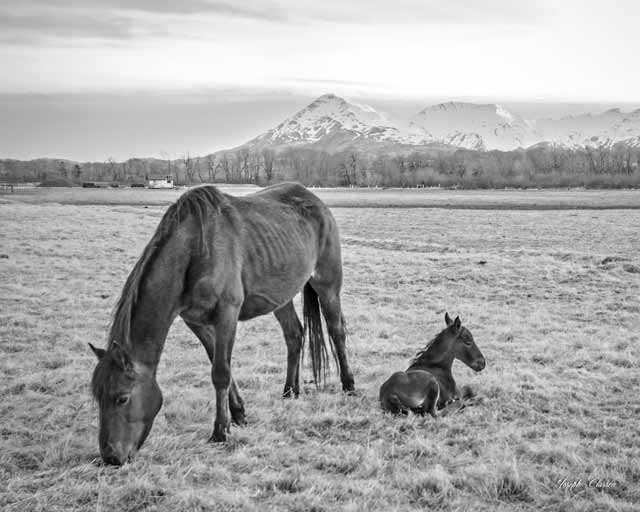
Mama and Baby Horse
While horses are not necessarily considered “wildlife” in Alaska, they still make for excellent photography subjects. Just be sure that your photo session does not upset the rancher or the animals themselves.
But no matter what the case, do lots of pre-trip planning, don’t be afraid to ask lots and lots of questions (prior to traveling and while traveling) of those who can give you informed answers about Alaska, and cover all the bases as best you can. Alaska Department of Fish and Game is a great place to start.
Come on up to the last frontier and you’ll have an unforgettable photographic adventure! Start planning it, and most importantly…do it!
by Joseph Classen
All text & photos: © 2013 Joseph Classen. All rights reserved.

Leave a Reply